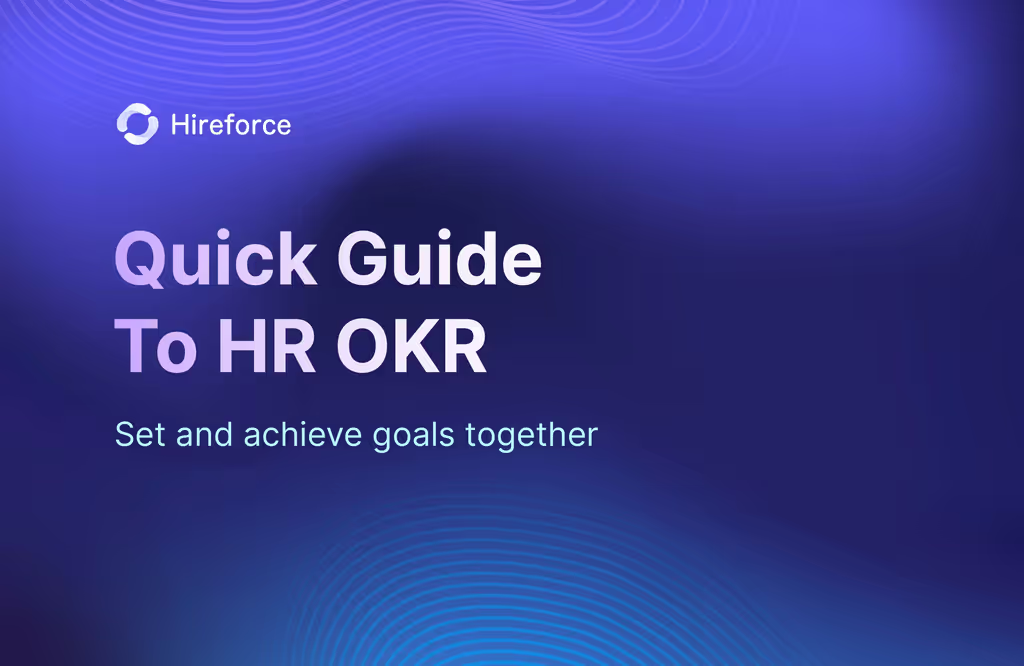When executed well, HR OKRs can be a real game-changer in leading high performance, alignment, and clarity for recruitment teams. So, let’s explore how OKRs work, especially for HR and recruitment teams and how they differ from other OKRs across a business.
What Are OKRs?
At the core, OKRs help teams set clear, measurable goals and track their progress:
- Objectives – a broad goal that defines what you want to achieve.
- Key results – specific, measurable outcomes that indicate if you’ve achieved your objective.
OKRs are intended to bring focus and alignment across teams and ensure that everyone’s efforts are working towards the same bigger-picture goals.

HR OKRs compare with other departments
Although OKRs are implemented across many departments, there is a significant difference between how OKRs flow in HR and other functions like Marketing, Sales, Product development, etc. This has to do with the nature of the objectives in every department and how success is measured in each.
For comparison, Sales or Marketing OKRs often focus on:
- Revenue growth
- Customer acquisition
- Market expansion
- Lead generation
These will be measurable in nature and also aligned with direct financial outcomes. For example, OKRs for a sales department might be “grow quarterly revenue by 15%,” while its key results might be “close 10 new enterprise clients” or “increase the average deal size by 20%.”
On the contrary, HR OKRs are more focused on people-centric and long-term objectives:
- Talent acquisition
- Employee engagement
- Retention and development
- Diversity and inclusion
These goals are a bit more challenging to measure and less concrete. For example, the HR objective may be “Improve employee engagement.” Some key results might be “Increase employee engagement scores by 10%” or “Reduce turnover by 15%.”
Key differences between HR and other departments OKR
- Quantifiability: Focus on more qualitative aspects such as employee satisfaction or culture-building, which are more challenging to directly quantify but essential for long-term success. Measuring success in HR often requires a mix of direct metrics (like turnover rates) and softer metrics (like engagement scores).
- Time horizon: HR’s OKRs often take longer to bear fruit. Improving employee engagement, building a solid company culture, or enhancing diversity initiatives are long-term goals that may not show immediate impact but are crucial for sustainability.
- Alignment with people: HR OKRs are heavily aligned with internal people processes. Employee development, satisfaction, and overall experience drive this focus. Strong people management fosters a healthy, productive workforce that will have follow-on effects on the longevity of the entire company. On the other hand, sale/marketing OKRs usually relate to outside factors, such as customers.
- Impact of failure: Failing to meet HR objectives, such as poor employee engagement or high turnover, may not have immediate financial consequences but could lead to severe long-term damage to company culture, morale, and retention rates.
HR OKR examples
1. Employee engagement
- Objective: Increase employee engagement across the organization.
- Key results:
- Achieve a 70% participation rate in the annual employee engagement survey.
- Improve engagement survey scores by 10% year over year.
- Implement 3 new initiatives based on employee feedback within 6 months.
- Key results:
2. Talent acquisition
- Objective: Improve the recruitment process to attract top talent.
- Key results:
- Reduce time-to-hire from 45 days to 30 days.
- Increase offer acceptance rate by 15%.
- Source 30% of candidates from employee referrals.
3. Employee retention
- Objective: Reduce employee turnover by fostering a positive work environment.
- Key results:
- Lower employee turnover from 12% to 8% in the next 6 months.
- Conduct exit interviews with 100% of departing employees and address the top 3 concerns.
- Increase internal promotion rate by 20%.
4. Diversity and Inclusion (DEI)
- Objective: Promote diversity and inclusion in the workforce.
- Key results:
- Achieve 35% diversity in all new hires.
- Conduct 3 company-wide diversity and inclusion training sessions.
- Create partnerships with 5 organizations to enhance diverse talent pipelines.
5. Employee training and development
- Objective: Strengthen employee skill sets through targeted training programs.
- Key results:
- Ensure 80% of employees complete at least one professional development course per quarter.
- Increase manager satisfaction with employee performance by 15%.
- Establish a mentorship program, pairing 30% of employees with a mentor.
6. Employer branding
- Objective: Improve the company’s reputation as a top employer.
- Key results:
- Increase social media engagement on employer branding posts by 50%.
- Achieve a Glassdoor rating of 4.5 or higher within 12 months.
- Host 4 recruitment events targeting potential candidates from underrepresented groups.
- Key results:
7. Operations efficiency
- Objective: Streamline HR operations to improve efficiency.
- Key results:
- Automate 60% of repetitive HR processes by the end of Q4.
- Reduce the average response time to employee inquiries by 25%.
- Implement an HRIS system that improves data accuracy by 95%.
- Key results:
8. Performance management
- Objective: Enhance the performance review process for greater employee development.
- Key results:
- Achieve a 90% completion rate for quarterly performance reviews.
- Increase employee satisfaction with the performance review process by 20%.
- Establish continuous feedback loops, with 80% of managers conducting monthly check-ins.
- Key results:

Why HR OKR matters
Though HR OKRs might seem less tangible than sales or marketing OKRs, their impact is often far-reaching. When HR teams focus on creating strong, cohesive teams, the company benefits from higher retention, better morale, and better performance across all departments. So, while OKRs in other business areas may focus on immediate outcomes like revenue, HR’s focus on long-term team-building is just as vital to a company’s success, if not more so.
Are you prioritizing team strength in your OKRs? The real question isn’t just whether your company is growing but whether your people are thriving as part of that growth.





